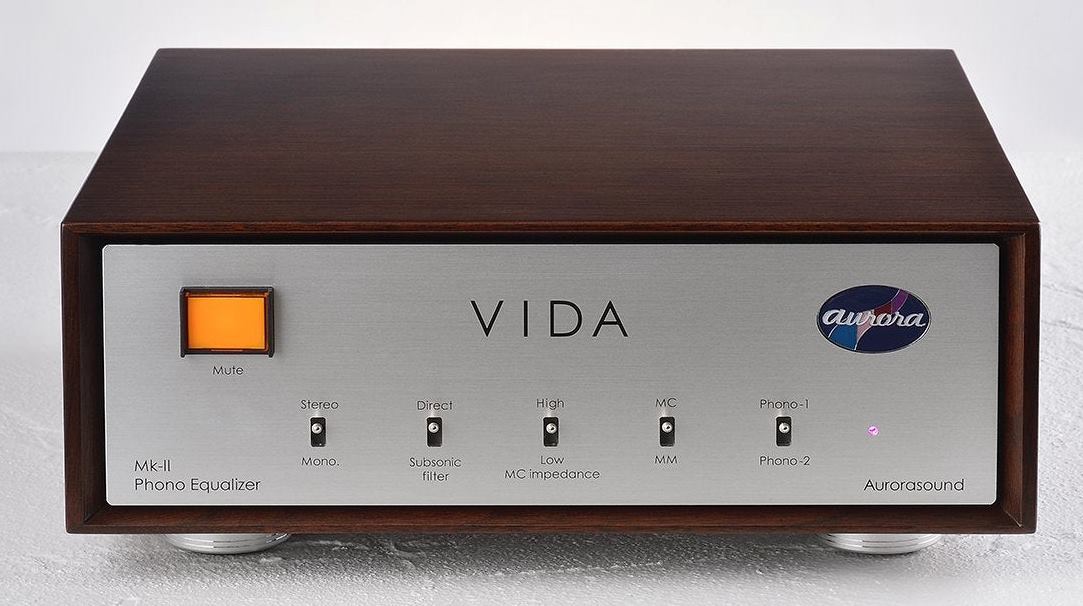Aurorasound is located in Yokohama, Japan. Shinobu Karaki has 28 years’ experience working for Texas Instruments Japan, Inc. He is a passionate musician, music teacher and a long-time audiophile. His love of music, combined with trained ears and extensive know-how in electronics and integrated circuits makes Mr. Karaki well suited to design high-end audio components.
Shinobu Karaki-san’s designs are state of the art innovative semiconductor technology and combined with excellent craftmanship makes his audio products worthy of review. There are a number of very positive reviews, along with awards, online. There are three phono preamplifiers in the product line: VIDA Supreme $12,790, VIDA Mk.II $5,290, and the VIDA Prima $1,200. The VIDA Mk.II is housed in an attractive wood-grain enclosure measuring 9 x 9.7 x 3.3 inches and weighing about 8.4 pounds, with an external power supply. The VIDA Mk.II offers 65dB of gain in Moving Coil mode, or 40 dB for Moving Magnet cartridges. There are three loading options: MC-Low for <10 Ohm DCR cartridges, MC–High for >10 Ohm moving coils, and MM for 47k Ohm loading. Modern cartridges tend to be better controlled on their high frequency performance and don’t require as much loading as early models demanded to tame the treble. Try the MC-High loading first. If it sounds harsh or rough, then switch loading to MC-Low.
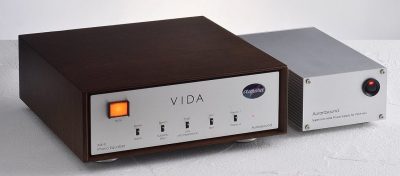
From the distributor’s product page: “Internal circuit, PCB, PSU, specifications and sonic performance have been refined. Among other things the L/R channel separation improved +6dB, THD+N factor improved from 0.028% to 0.012%, new amp modules (gold-plated, developed for the VIDA Supreme), inputs for 2 MC or 2 MM cartridges at the same time (or 1 each) and the US version now comes standard with a 6-position impedance selector switch for MC on the backside.”
The switches for cartridge type and load impedance are easily accessible on the front panel. The power switch is on the rear panel of the external power supply, and the VIDA Mk.II is meant to be left powered on at all times. On the front panel is a large Mute button that requires just a light touch to activate. The action of the Mute switch has improved with the Mk.II model and requires only a gentle touch to engage Mute. The VIDA Mk.II can accommodate two concurrent cartridge connections and was auditioned with two moving coil phono cartridges: a 16 Ohm DCR Miyajima Destiny and a 1 Ohm ZYX UNIverse Optimum. The Destiny lists for $7,600 and the Optimum for $17,995. The stage is set!
The VIDA Mk.II was auditioned with an Acoustic Signature Montana Neo turntable with Acoustic Signature TA-7000 Neo and Origin Live Agile tonearms. On hand are Acoustic Signature Grip, Stillpoints Ultra-LPI mk2, and Origin Live Gravity record clamps. The best sound is obtained with the Grip clamp sitting atop the Gravity clamp.
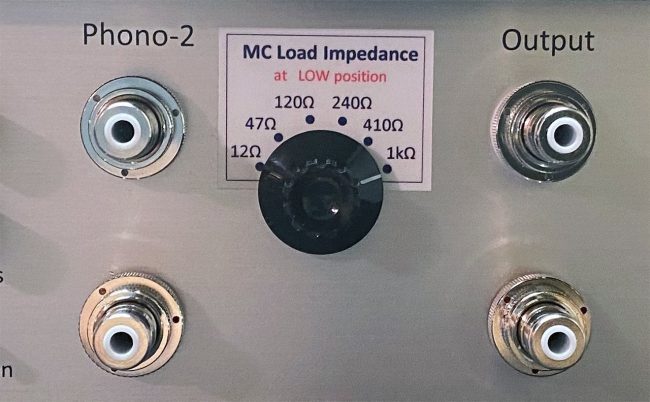
Other components on hand include the BMC MCCI ULN phono preamplifier; Soulution 325 with phono, Pass XP-22, and Benchmark HPA4 preamplifiers; Valvet E2 SE and Benchmark AHB2 power amplifiers; Alta Celesta FRM-2M, and Magico S1 MkII speakers which are lightly augmented in the low bass with a pair of JL Audio e110 subwoofers. Digital is handled by a custom Windows computer running JRiver Media Center with a USB-connected Audio-gd R7 mk.2 DAC. The audio cabling is Audioquest WEL Signature and Mogami interconnects and speaker cables. USB cables are StraightWire USB-F. Power protection and purification are provided by a PS Audio Dectet for the preamplifiers and source components, and a PS Audio Quintet for the power amplifiers. The Quintet includes a standard 1/8″ trigger connection for remote turn-on and -off of power amplifiers that lack a 12V remote trigger. Power cords include my DIY power cord, and Straight Wire Pro Thunder. An Acoustic Signature Grip, Origin Live Gravity, and the new Stillpoints Ultra-LPI mk2 record clamps were employed during the review period.
Also in use during the audition is the new, optional power cable that connects the power supply and VIDA Mk.II. The Aurorasound VIDA SPC Umbilical Cord, $399, which is standard equipment on the VIDA Supreme, instantly elevates the sonic performance of this phono stage, increasing upper frequency clarity and presenting a sound stage that is larger and better defined.
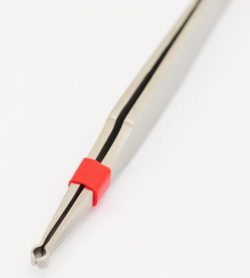
Two accessories, kindly sent by Alfred Kainz at HighEnd Electronics, are the Nasotec Tweezers For Headshell Leads, $30, and the Nasotec Cartridge Alignment Block, $55. Both of these came in very handy and did their jobs perfectly during the changes of cartridges and arms used in this review. The alignment Block helped to efficiently align the cartridge VTA and azimuth. This speeded up the process of performing the final settings by ear. The tweezers did their job extremely well on both the Acoustic Signature and Origin Live tonearms and is highly recommended.
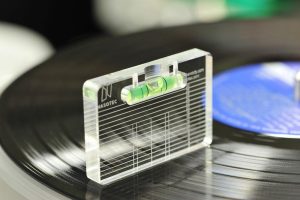
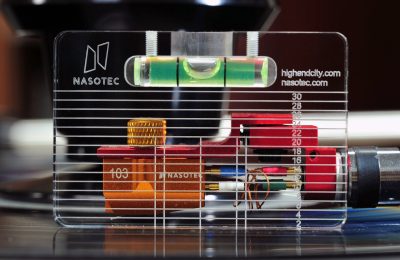
As with the Aurorasound VIDA Prima, there are no pops or other noises when switching gain or loading or when engaging the big Mute switch on the front panel. The noise level, with no record playing and the volume at a normal listening level, is audible as a low hiss from about 1 ft from the speaker with the 0.1mV DCR ZYX cartridge, or a challenge to hear at all from the speakers with the 0.23mV Miyajima cartridge. The background hiss has an unusually low amount of high frequency content, making its presence less audible and objectionable. Although not available for direct comparison, the noise level of the VIDA Mk.II seems lower or quieter than the VIDA Prima.
The VIDA Mk.II continues the family sound of the VIDA Prima, offering neutrality with excellent dynamic performance. The ability to go from very soft to very loud instantly confirms that the external power supply has ample power reserves. Even at low volume levels, the dynamic performance of the preamplifier is clearly evident, delivering the power and propulsion of music at any volume setting you might care to listen.
The upper frequencies have excellent resolution and extension. While not quite the extreme performance of the BMC MCCI ULN phono stage in the treble range, the VIDA Mk.II rarely disappoints in the upper range, especially when the SPC Umbilical Cord is installed. A wonderfully rich and textured midrange is apparent as voices are delivered with a clear sense of humanity and correctness.
Listen to Kim Carnes Mistaken Identity LP. The cut “Draw of the Cards” has huge dynamic impact and power with entertaining effects that roll around the listening room. The solid foundation in the lower frequencies gives music a realistic presence that increases believability and enjoyment. The bass performance is never hyped, but accurately delivers what is in the recording. Whether symphonic tympani or the studio-enhanced bass on Michael Jackson’s “Thriller”, you will hear the entire bass character that your phono cartridge is capable of sending down the line.
The judges on the NBC show “The Voice” often comment on a singer’s “tone”. Tone can also be referred to as harmonic depth or completion of every note. The VIDA Mk.II has copious tone, offering voices that have exceptional humanity and truth.
Percussion is very well served by the VIDA Mk.II. This phono stage delivers an excellent leading-edge to every sound with correct and clear impact. This indicates the presence of a good power supply, able to serve the instantaneous needs of the audio circuitry. Not only is the initial impulse produced with speed and resolution, but the next few milliseconds complete the picture of the stick, beater, or mallet.
 Switching loading from MC-high to MC-low brings down the treble into a more midrange focus and gives a small increase in bass power. This is exactly what we expect with changes in load resistances. By midrange focus, I mean a bit less air and extreme high frequencies, but more prominent vocals. That’s what increased loading does: decrease upper treble glare from ringing and sounding harsh. The goal is to find that setting where the glare is gone without removing some worthwhile high frequency content. For both the ZYX Optimum and the Miyajima Madake, MC-high sounded best. Both cartridges suffer very little from high frequency ringing that would require greater loading (fewer Ohms).
Switching loading from MC-high to MC-low brings down the treble into a more midrange focus and gives a small increase in bass power. This is exactly what we expect with changes in load resistances. By midrange focus, I mean a bit less air and extreme high frequencies, but more prominent vocals. That’s what increased loading does: decrease upper treble glare from ringing and sounding harsh. The goal is to find that setting where the glare is gone without removing some worthwhile high frequency content. For both the ZYX Optimum and the Miyajima Madake, MC-high sounded best. Both cartridges suffer very little from high frequency ringing that would require greater loading (fewer Ohms).
Loading is a trade-off. Typically, higher resistor values offer more extended treble range with an increase in low level detail, while the bass can suffer with reduced power and definition. Lower values, for example 10 or 100 Ohms, can tame a cartridge’s brittle treble. A good rule is to use the highest values (less load) where cartridge ringing, and the attendant glare or harshness, is not a problem.
The lower frequencies, specifically the mid to low bass below 100 cycles per second, are well demonstrated by the song “Oh Yeah!” on the album Stella by the very dynamic band Yello. The entire bass range is commanding, powerful, and very present. If you are using subwoofers, they might require some adjustments in crossover frequency and level – downward. There are also other good cuts on this album. The song “Vicious Games” has some kick and interesting things happening, and with singing in the far background. The VIDA Mk.II delivers a very clear and immersive performance. The upper frequencies offer very long-lasting harmonics without glare or harshness.
There is outstanding texture and vocal presence in Bonnie Raitt’s Sweet Forgiveness LP. Bonnie’s voice is unmistakably hers and very sweet. In “Opening Farewell”, the tapping on the cymbal rings very clearly, with the cymbal itself never degrading into some white noise-like harshness.
One very welcome feature of the VIDA Mk.II is the presence on the rear panel of two grounding binding posts. Since the phono stage will accept two different phono cartridge connections, the inclusion of a separate binding post to ground each connection is logical and very handy. No longer will you have to try to get two wires, or two spade connectors, to fit snugly onto one binding post. Thank you!
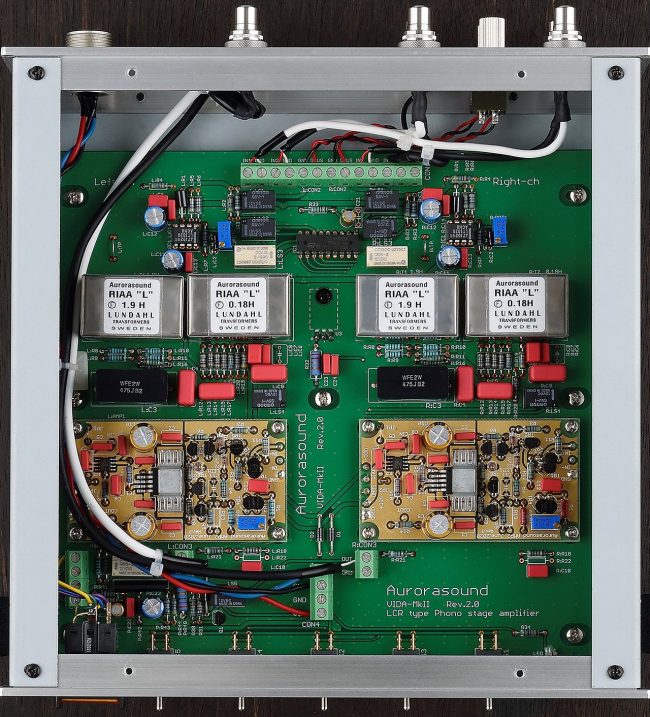
At this level of performance, often referred to as “awfully good”, system matching is just as important to the final sound of your audio system as how well a single component performs. The BMC unit offers a bit more air and extension with the very low output ZYX cartridge, and while this difference is still audible when that cartridge is used with the VIDA, the difference is smaller. The Miyajima Destiny sounds better overall when used with the VIDA than when connected to the BMC: the Destiny loves the VIDA! The overall technical merit, and more importantly, the musical merit of this pairing is more than satisfactory. There is a very truthful harmonic depth and richness across the octaves, not at all sterile or bleached.
There is an upgrade available in the Aurorasound VIDA Supreme phono preamplifier. I hope to someday find out what this higher performance component can do. Watch these pages! The VIDA Mk.II is a very musical design that delivers a complete sonic picture with resolution that is the analog equivalent to 8k video.
The VIDA Mk.II sets a very high bar for sonic performance and is an even better value than the lower cost VIDA Prima. This is a very truthful, very neutral, high resolution and enjoyable phono preamplifier. The VIDA Mk.II is an excellent performer, offering more than a suggestion of the best phono preamps. Anyone shopping for a phono stage under about $20k might be surprised at this unit’s truly excellent and musically satisfying abilities. The VIDA Mk.II could possibly let you delete the word “upgrade” from your thoughts.
Overall Rating: 9.5 LPs
Link to manufacturer: High End Electronics
This review would not have been possible without the very kind support of Alfred Kainz at High End electronics. Thank you!

